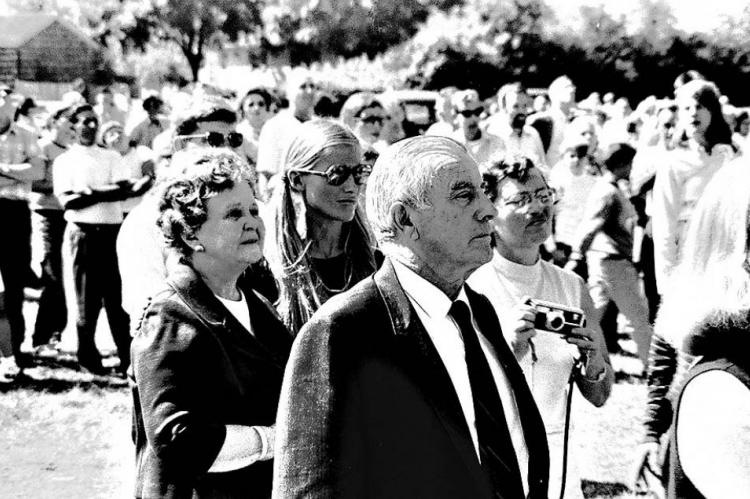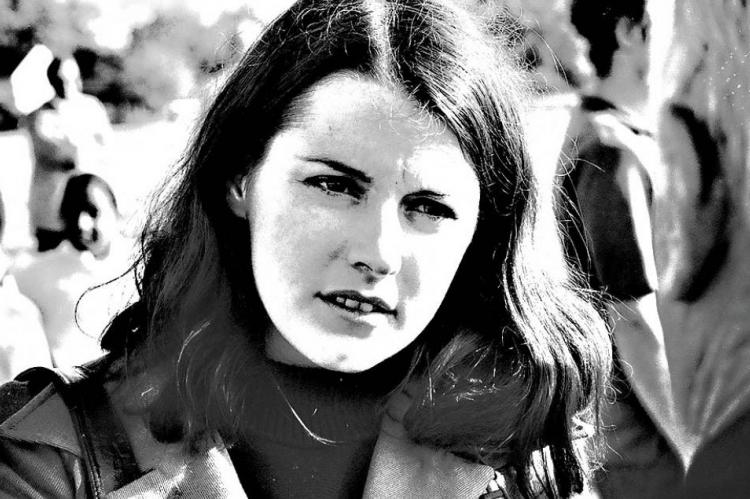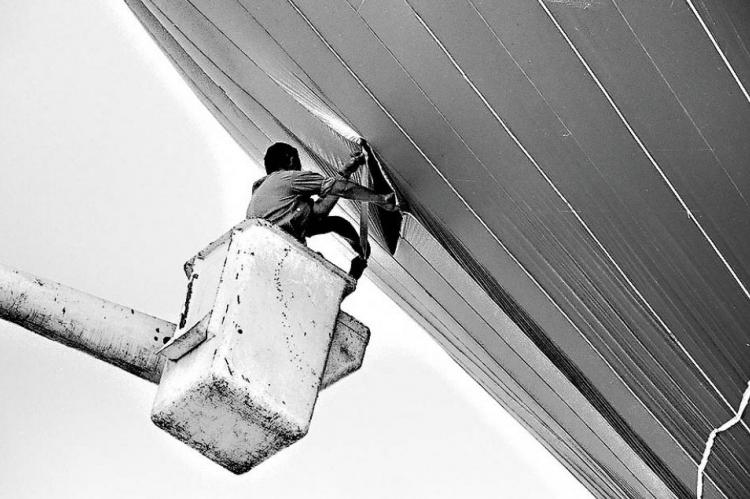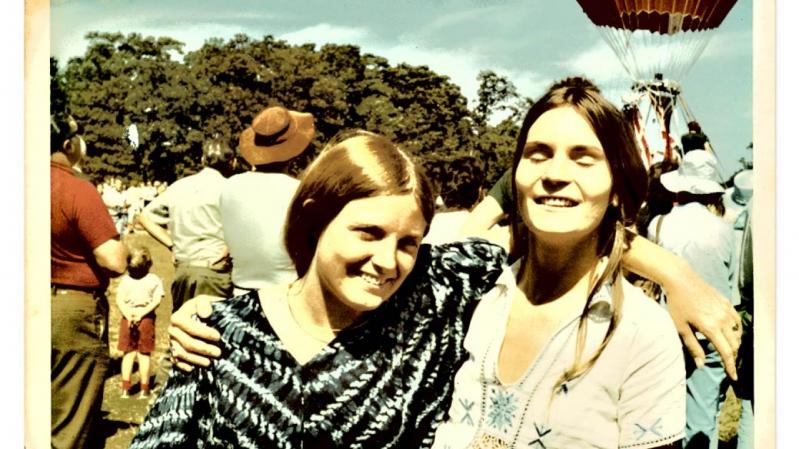When a crowd gathers for the commencement of an event greater than itself, something like magic happens. The relighting of the old Sag Harbor Cinema sign this past Memorial Day weekend was such a moment. So was the clear April day in 2007 when onlookers lined Pantigo Road to watch several 18th-century buildings carried down the road on trucks to become East Hampton’s new Town Hall. These gatherings tend to evoke another era, when commemorations and celebrations were more abundant, from the moon landings to bicentennial parades of tall ships in harbors. They encapsulate the hope, tenacity, bravery, and stupidity that got us to where we, as Americans, were then. The freedom of flight, of wind and sail, and the bullheaded notion we could order the elements to lead us into greatness — these were part of the fiber of the Land of the Free.
The 1960s and early 1970s was an era of social and cultural reaching: toward freedom of speech and protest and away from racism and narrow-thinking institutions. Everywhere, citizens were breaking the constraints — of bras and boards of education and color barriers. The Free Life, a Rozière helium balloon crafted to cross the Atlantic from East Hampton to France in 1970, was thus aptly named.
Over a thousand people gathered at George Miller’s pasture in Springs on Sept. 20, almost 50 years ago, with a heightened sense of determination to witness the launch of the Free Life. Inside the unusually shaped, shallow gondola were an attractive couple, Rodney Anderson and Pamela Brown, and their equally charming British aeronautic pilot, Malcolm Brighton. The three were to cross the wide-open sea in their hot-air balloon, something that aeronauts had been trying and failing to do since 1836 when Charles Green became famous for piloting his Great Nassau balloon. The launch of the Free Life would symbolize everything that was still strong, adventurous, hope-filled, and fun about our country and, in particular, its young people.
America was in a peculiar mood. It was like daybreak after an all-night party, when some of the partygoers are still blithely high but most are coming down. The country had not gotten over the psychic blow of the assassinations two years before of Reverend Martin Luther King Jr. and Bobby Kennedy. It was experiencing its first recession in years, a presage of the more serious mid-70s recession to come. The bloody war in Vietnam was dividing its citizens. Yet, we were only halfway through the Apollo landings, a series of miracles that dazzled all nations. Days before the Free Life cut its tether to the Earth, the new supersonic airplane Concorde landed at Heathrow for the first time. Things were possible that were once deemed impossible. Impossible things needed to be possible.
For the residents of East Hampton, it was not every day they got to see, up close, such an enormous aircraft as it lifted off into the clear sky and moved silently over the wetlands and creeks, the shingled saltbox houses of early settlers, and the peaceful blue stretch of Accabonac Harbor. The balloon was a thrilling and gorgeous sight: orange-red, with white and yellow stripes at its crown and the sans serif words The Free Life girding its middle and running down one side.
According to contemporary reports, the gondola carried a radio, an inflatable life raft, a cot, a case of Champagne, 10 bottles of propane, and enough food for three or four days. An East Hampton Town Police boat had towed the gondola around Gardiner’s Bay, to test whether it would float; the buoyancy mechanism was hundreds of Ping-Pong balls fixed to the gondola's liner.
By some accounts, there was a feeling of unease before liftoff. The East Hampton Star noted that spectators had been concerned to observe a triangular hole, three feet across, torn into the balloon’s outer shell. It was patched at the eleventh hour with tape and a bit of material on which some jokester had written For Sale; the patch was falling off by takeoff, as can be seen in photographs taken that morning. The aeronauts assured everyone that a tear in the outer shell was of no consequence: It was the inner lining that held the hot air. Still, whether or not a breach in the insulating outer shell would have an impact on what was to come — when the Free Life’s burner had gone out and the balloon was cruising east from Newfoundland in cold weather — is a question that apparently remains unanswered.

Robin Kuntz, The Star’s business manager, was a neighborhood kid who rode her bike to the field. She remembers a general sense that something was not right: “Everyone was saying that day that they shouldn’t go. It wasn’t going to happen, it wasn’t supposed to happen — I don’t know if it was the wind, or conditions weren’t right. . . . The day before, we had been there all day, and then we were there all morning. So we biked home, and by the time we got home, it was gone.”
Jack Graves, The East Hampton Star’s venerable sportswriter, has never forgotten that day, either. “They did not look fearful — they were ready to go,” he says. “To see them off was really something. Everybody in that field was pulling for them.”
Pamela Brown’s father was there, eager to watch his daughter take flight. Pamela‘s mother, however, remained at home in Texas, filled with anxiety and foreboding.
The Star described the scene as “a beautiful, old-fashioned, surrealist pageant,” with hippies in riding helmets, fishermen and grocers in work clothes.
“Miller’s field was filled with excited people arriving in the night to witness the inflation of the seven-stories-tall balloon — an awesome sight,” says Genie Chipps Henderson, who probably knew the adventurers better than anyone in town. “The international press was there, TV cameras were set in place atop network vans. When the dawn came and the wind was blowing in the wrong direction, the field came alive with blankets and picnics, Frisbees, dogs, and children.”
By midday, the wind shifted. Malcolm, who’d been in constant contact with weather experts at New York University, declared that countdown would begin at 1:40. “Flags were unfurled, Champagne uncorked, Pam set her camera to rolling,” Henderson says, “while the volunteer fire department of Spring, as well as Willem de Kooning and other artists, mechanics, and Springs locals held tight to the rigging.”
The balloon was set loose from its tethers while the ground crew still held onto the sides of the gondola as it skimmed across the meadow. Ten sandbags were dropped over the side. After a swift christening with Champagne, The Star reported, the 11th and then 12th sandbags were tossed over.
Pamela was heard to call out “Daddy Brown, Daddy Brown!” as the Free Life lifted off. She wanted to catch her father — who had tears in his eyes and was one of the few men present dressed in a suit — on film. Rod stood holding onto a strap, a Cigarillo cigar clamped between his teeth, like Errol Flynn. Malcolm’s final words through the megaphone were: “Let go!”
Pamela Faris Brown was 28, a former Miss Lexington (Kentucky), the daughter of a politician and the sister of the C.E.O. of Kentucky Fried Chicken. She was an actress, too, having appeared regularly on a daytime soap called Love Is a Many Splendored Thing, and had joined the crew as a documentarian.
The flight was the brainchild of her husband, Rod. At 32, he had tried several jobs, but nothing stuck and he had recently turned to commodities trading. But his passion was this singular idea — casually dropped by a friend, almost as a joke—that he should be the first human to cross the Atlantic Ocean in a hot-air balloon.
Genie Chipps, who was Pamela’s close friend, is now an author and the archivist for LTV Studios in Wainscott. She is married to Bill Henderson, founder and editor of the Pushcart Press, which is run out of their house in Springs, less than a mile from where the Free Life took off. Genie and Pamela had grown up together in Kentucky. “As long as I had known her,” she says of Pamela, “she loved an intriguing idea, was ready to plunge ahead on all sorts of escapades, and she was fearless.”
While preparing for their flight, the couple stayed in a cottage behind the home of the VanDewater family, at 775 Fireplace Road. “Mom” VanDewater was an enthusiastic supporter of the flight and had given the couple housing when they could find none available during the busy summer.
“The local people really took to them,” Graves recalls. The chief of the Springs Fire Department and several other Bonackers offered assistance with various things, including tinkering with the propane hot-air burner, which was reportedly a bit temperamental.
“There were two points of view,” Graves says, “the yea-sayers and the naysayers. Some of us were thinking, Maybe you should wait? I mean, it was really, really risky. But there was no stopping them.” At the last moment, Graves says, Brown and Anderson “got Malcolm Brighton to come over, and very quickly.”
Brighton had come over to meet the Andersons in August, at their request, and to decide if he would pilot their balloon. Their original pilot had backed out due to mechanical concerns. According to The Free Life: The Spirit of Courage, Folly, and Obsession by Anthony Smith, Brighton did not take long to agree to the voyage, but, first, he had to return to England briefly to fly another balloon over the Isle of Wight music festival, where Bob Dylan, the Who, and Sly and the Family Stone were playing for the largest concert gathering on record. He returned to East Hampton only a few weeks before the Free Life was scheduled to launch. It was during these weeks that the Andersons and Brighton and Genie Chipps bonded as a tireless team dedicated to seeing the Free Life airborne.
Smith was a noted British science and travel writer, and Brighton’s close friend. He was also often Brighton’s partner in balloon piloting — and it was he who might have tried to talk his friend out of the flight . . . if he had been in Springs. Instead, he was back in London, finishing up a months-long survey via boat, bicycle, and inflatable along 6,000 miles of English coastline. He did not even know of Malcolm’s sudden plans. When he heard over the radio news that his friend and the couple had set off on the trans-Atlantic crossing, Smith was surprised, even a little shocked. Malcolm had left his wife and two young children in Surrey to do what seemed, from the outset, a dangerous mission. But, according to his book, Smith assumed that Malcolm knew what he was getting into and how to do it safely. The two had been hired to create a gas-air ship for the Disney film Chitty Chitty Bang Bang, and later worked with the actor-director Albert Finney on another craft for one of his films. They had flown over the African continent together.

By Monday, the balloon had traveled north of Massachusetts and was passing Nova Scotia, the trajectory unfolding more or less to plan. By lunchtime, its crew was, according to a report in The Star, eating roast beef and in good spirits high above Sable Island, despite the fact that they were heading into a cold front and a sheet of hard rain — and they were having serious trouble with the propane burner. The Free Life was designed for lightness, ease, and comfort, not for the impact of strong rain or landing in high waves.
Around 3 p.m., they reportedly exchanged salutations with a passing Portuguese airliner. Not long after, when a U.S. Air Force pilot returning home from a deployment radioed the Free Life crew, Malcolm reported that they were fine and cruising at 7,000 feet, but that the burner had gone out the night before in the rain.
After nightfall, probably around 9 p.m. and some 400 miles off St. John’s, Newfoundland, the party sent a distress message: “Gander November Two Zero Seven Niner: We are ditching. We are approximately one hundred miles west of Delta. We are ditching. . . . November Two Zero Seven Niner is going into the water. . . . We request search and rescue. Over. We are at 600 feet and descending. I am now signing off to go through the safest possible landing procedure. We will try and contact you after landing. Over and out.”
The weather was bad, with a low ceiling, winds howling at up to 45 knots, and rough seas. The message was the last anyone would see or hear of Brown, Anderson, and Brighton.

After the Free Life disappeared, and fairly soon into the ensuing investigations, a picture emerged of a couple whose inexperience was matched only by their ability to dream big, with the almost delusional desire to succeed, regardless of the obstacles and odds. And while it seemed curious that such an experienced pilot as Malcolm Brighton would have been roped into the expedition, he had recently been struggling through a series of stresses — both financial and medical, according to Brighton’s wife, who descibed the situation in Smith’s book — and these troubles, it seems, had left him with a craving for life-affirming adventure.
That, and the undeniably glamorous pull of the couple spearheading the journey. Energetic and enthusiastic, Anderson and Brown had — by all accounts — wanted to prove to the world, and their families, that they could accomplish something great; that they could be two people who were bigger and brighter than anyone would have expected them to be.
The novelist Ian McEwan gives a poetic and ominous description in his book Enduring Love, about ordinary people drawn into a tragic hot-air balloon mishap. There is the “buzzard’s perspective” of a flat, green field and the people gathered on it; and an enormous balloon filled with “that elemental gas forged from hydrogen in the nuclear furnace of the stars.” And, also, the catastrophe that is willingly run toward. The image seems, in hindsight, eerily similar to that day in Miller’s meadow.
The tale of the Free Life was front-page news in The Star for weeks, as well as the subject of editorials: “The enthusiastic spirit of the flight, generated in large part by a group of about 30 Springs residents who saw the project through months of preparation, was evident last weekend, and it readily spread to the 1,000 men, women, and children who came to watch Sunday.”
The newspaper noted that Anderson and Brown lived on 79th Street in Manhattan and “had no reason for choosing Springs as the takeoff point for the Free Life other than its location and topography.” Yet their enthusiasm had been contagious almost immediately, drawing many from what was then a small town into their big dream.

A Life magazine camera had been mounted on the boom to film the crew en route to Europe, and WCBS television sold “first-day covers” (envelopes to be carried across and mailed back from Europe to the purchasers) to help finance the trip. The camera no doubt captured the image of well-wishers as they ran across the field chasing the sun-colored balloon as it rose and floated east. Perhaps it also captured the dark skies that brought it back to Earth.
Pamela herself had a movie camera in hand. She filmed the scene from the balloon as it rose, then threw the camera over to her friend Genie at the last minute. Genie still has the footage.
In many ways, the flight of the Free Life was evocative of a still earlier era. There would have still been, in that field, old men who could remember the zeppelins of World War I. But there were very few young aeronauts who had the experience or skill to fly a hot-air craft long distances. In that, Malcolm was in a class by himself. According to Smith, when those in Europe who did know something of ballooning found out about the proposed flight of the Free Life, they offered Malcolm their resounding opinion that the excursion was foolhardy at best and dangerous at worst. The shape and weight of the gondola, the distance of the flight, and the unpredictability of winds and weather patterns combined to form an insurmountable wall of obstacles. But, it seems, Malcolm was a Brit made of the stuff of Arctic explorers and discoverers of vast, hidden waterways and he was not to be dissuaded.
Did the adventurers assume that the American and Canadian Coast Guards would rescue them quickly should they have to land on water?
No doubt there was also something about America’s greatness, a confidence born in the wake of World War II, that contributed to our brazenness of exploration in general and to the Free Life in specific: A capsule shooting across space to the Moon? Why not? A hot-air balloon crossing the Atlantic? Of course!
Perhaps the passengers of the Free Life, in their hearts, knew catastrophe awaited and willingly ran toward it. Perhaps there was no turning back, either way. For, in the giddy promise of accomplishing that which is impossible, there is always the realization that it might, in fact, be impossible, in the end.
“If any one word could describe it,” says Genie Henderson, “it would be magical. For one brief moment, time was suspended in perfection and it was as if we too might suddenly be lifted up into the blue sky.”

